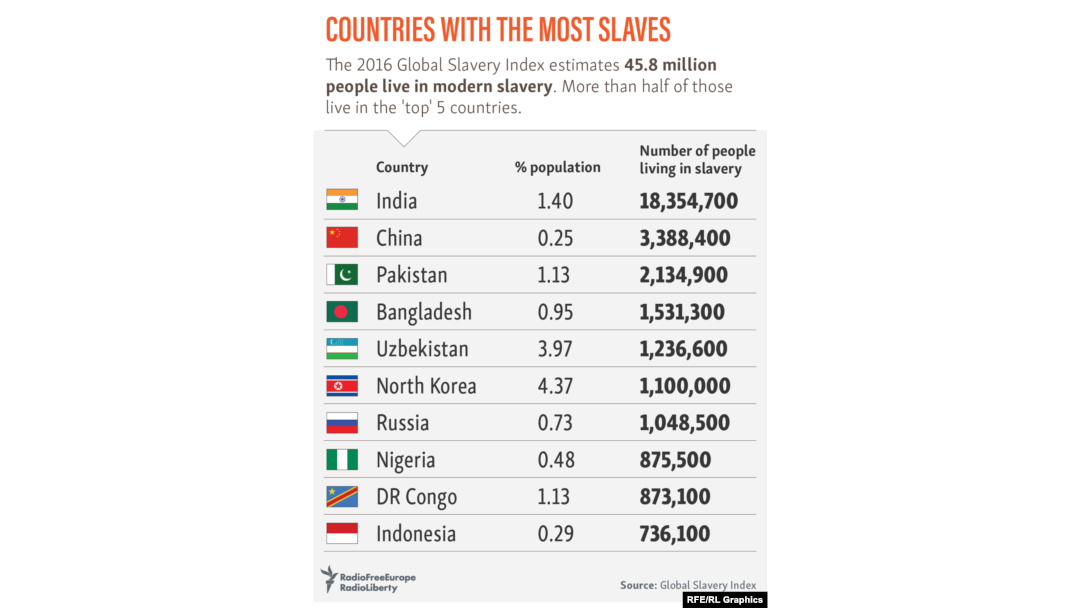A new report on global slavery ranks Uzbekistan and Pakistan among the five worst offenders in terms of the number of people forced into modern slavery.
With its forced labor in the cotton fields, Uzbekistan also was estimated to be the world’s second-worst country when ranked by the prevalence of slavery in proportion to the population.
The findings are contained in the 2016 Global Slavery Index, which was released on May 31 by an Australia-based nongovernmental organization called the Walk Free Foundation.
Around the world, the report says, there are now almost 46 million people who are enslaved.
Andrew Forrest, the chairman and co-founder of the Walk Free Foundation, told RFE/RL on May 31 that the 2016 estimate is more than 10 million higher than the findings from his organization’s 2014 research.
Forrest said he thinks slavery is increasing in the world and that “it will probably get worse before it gets better and then is finally eliminated.”
The definition of “modern slavery” includes people who are trapped in forced labor, human trafficking, debt bondage, sex trafficking, forced marriage, and other “slavelike exploitation.”
The study’s leading author, University of Hull professor Kevin Bales, says slavery can be defined as “a relationship in which one person is controlled by another through violence, the threat of violence, or psychological coercion, has lost free will and free movement, is exploited economically, and is paid nothing beyond subsistence."

He says “modern-day slavery takes various forms and achieves certain ends” but its outcome is “always exploitative in nature: appropriation of labor for productive activities resulting in economic gain.”
The report says Uzbekistan ranks near the top of the shame list for modern slavery because the government in Tashkent uses one of the world’s largest state-sponsored systems of forced labor to harvest cotton.
Uzbekistan’s government denies that forced labor is an official policy. It claims its citizens volunteer out of civic responsibility and take part in a form of traditional voluntary labor called “khashar.”
But Forrest notes that employees of local administrations, teachers, factory workers, state firms, and doctors are forced to leave their jobs every autumn for weeks at a time to pick cotton with little or no additional compensation.
Those who refuse to take part are threatened with punishment and dismissal from their state-sector jobs, he said.
“That, unfortunately, defines itself as modern slavery,” Forrest said.
“The central leadership of the government [in Uzbekistan] is able to distribute those profits [from the cotton industry] as they see fit,” he said. “The people who made the profits, which is the people who plant the cotton and harvest the cotton, have no say in the distribution of that income. They are just there to do the government’s bidding, to make that revenue. And they see none of it.”
The Global Slavery Index says that authoritarian President Islam Karimov’s government, under pressure from international monitoring organizations, has “begun to take steps to improve the situation.”
But it says reports from the 2015 cotton harvest in the Central Asian country estimate that more than 1 million people were forced to work.
Only North Korea has a higher proportion of its population forced into modern slavery than Uzbekistan, the report says.
It says North Korea tops the list because of its extensive system of prison labor camps, and because many North Korean women are subjected to forced marriage and commercial sexual exploitation in China.
In absolute terms, the report said countries with the most people forced into slavery are India, China, Pakistan, Bangladesh, and Uzbekistan.
Forrest explained that Pakistan is high on the list because of the widespread practice of forced marriage and child marriage.
“Across Pakistan, wherever you have child marriages or you have marriages by force, it defines itself as modern slavery because those young girls have no say whatsoever in what is happening to them,” he said.
“They are absolutely under the control of someone else,” Forrest said. “They have no choice and they can never leave under their own free will. That, of course, meets the definition of slavery.”
The report listed North Korea and Iran as the two countries that were taking the least action to reduce modern slavery.
Governments that were praised for their efforts to combat modern slavery and forced labor include Croatia, Georgia, Montenegro, Macedonia, Moldova, Albania, and Serbia.
The 2016 Global Slavery Index includes a measure on state-sanctioned forced labor as a way of rating how governments respond to slavery.
It says state-sanctioned forced labor is “where the government forces the population, or segments of it, to work under the threat of penalty, and for which the person or population has not offered himself voluntarily.”
It said the countries that have systematically forced their population into labor include Uzbekistan, Turkmenistan, Tajikistan, Belarus, China, Eritrea, North Korea, Russia, and Vietnam.


